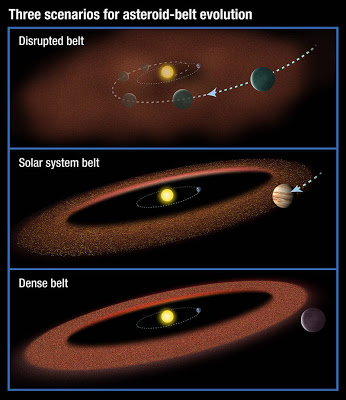

| Visitors Now: | |
| Total Visits: | |
| Total Stories: |

| Story Views | |
| Now: | |
| Last Hour: | |
| Last 24 Hours: | |
| Total: | |
One in 25 solar systems have Asteroid Belts at Just the Right Place to be Friendly to Life
From
NASA JPL – Solar systems with life-bearing planets may be rare if they are dependent on the presence of asteroid belts of just the right mass, according to a study by Rebecca Martin, a NASA Sagan Fellow from the University of Colorado in Boulder, and astronomer Mario Livio of the Space Telescope Science Institute in Baltimore, Md.
As solar systems form, they frequently acquire an asteroid belt around the “snow line” – the point where it's cold enough for volatile materials such as water to remain solid. But just having an asteroid belt isn't enough in itself; you need a large planet around to make sure the belt isn't too thick or too thin.
Life may need a Goldylocks asteroid belt that is just the right place and density.
Having too few collisions could mean that the planet is not properly seeded with material from the asteroids.
There might also be an issue if the asteroid belt causes too many collisions, where a technological civilization cannot develop without getting destroyed by an asteroid.
They suggest that the size and location of an asteroid belt, shaped by the evolution of the sun's planet-forming disk and by the gravitational influence of a nearby giant Jupiter-like planet, may determine whether complex life will evolve on an Earth-like planet.
This might sound surprising because asteroids are considered a nuisance due to their potential to impact Earth and trigger mass extinctions. But an emerging view proposes that asteroid collisions with planets may provide a boost to the birth and evolution of complex life.
Asteroids may have delivered water and organic compounds to the early Earth. According to the theory of punctuated equilibrium, occasional asteroid impacts might accelerate the rate of biological evolution by disrupting a planet's environment to the point where species must try new adaptation strategies.
See more and subscribe to NextBigFuture at 2012-11-03 04:43:33 Source: http://nextbigfuture.com/2012/11/one-in-25-solar-systems-have-asteroid.html
Source:



